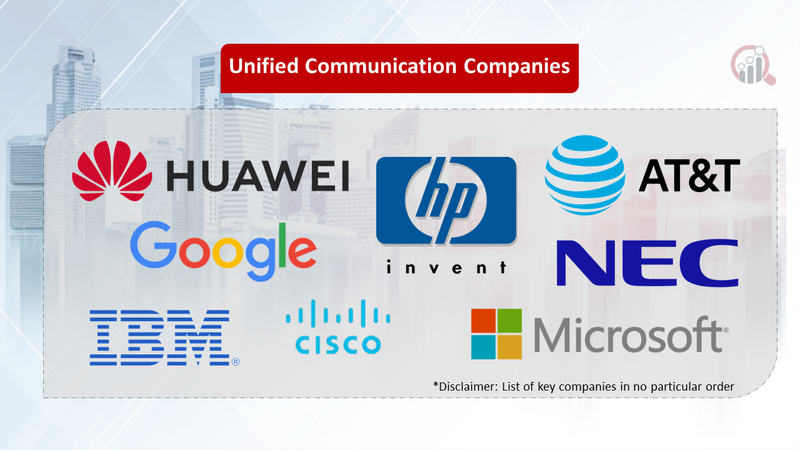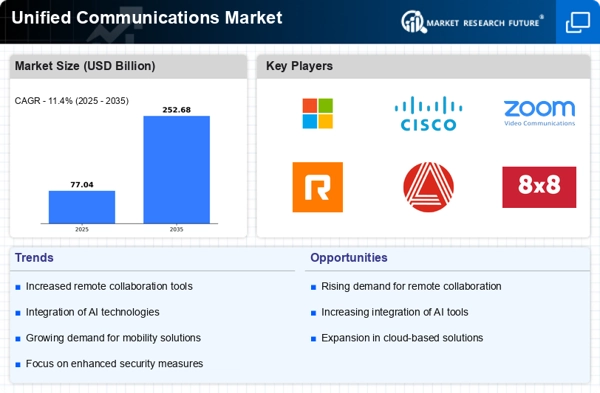Top Industry Leaders in the Unified Communications Market

Competitive Landscape of the Unified Communications Market: A Deep Dive
The Unified Communications (UC) market, encompassing a spectrum of technologies bridging various communication channels, continues to witness dynamic growth fuelled by the digital transformation wave. This rapid evolution demands a closer look at the competitive landscape, key players, and emerging trends.
Key Players:
-
Google LLC
-
NEC
-
Aastra
-
IBM Corporation
-
Siemens Enterprise Communications
-
Avaya Inc.
-
Verizon
-
Star2Star
-
Asnet
-
Orange
-
Mitel
-
Microsoft Corporation
-
Hewlett-Packard
-
RingCentral
-
NTT
-
Cisco Systems
-
Connect Solutions Unify
-
Huawei
-
At & T
-
Alcatel-Lucent S.A.
Strategies for Differentiation:
-
Cloud Migration: Players are prioritizing cloud-based UCaaS (Unified Communications as a Service) offerings, capitalizing on scalability, accessibility, and lower upfront costs. The increasing remote workforce and cloud adoption trends drive this shift.
-
Integration and Platform Play: Leading players focus on integrating UC solutions with complementary applications like CRM, analytics, and collaboration tools. Building comprehensive platforms for seamless communication and workflow management is key.
-
AI and Automation: The incorporation of AI into UC solutions for features like automated scheduling, sentiment analysis, and real-time translation adds significant value, enhancing user experience and productivity.
-
Vertical Specialization: Tailoring UC solutions to specific industries like healthcare, finance, or education opens up untapped market potential. Customization and industry-specific features resonate with these targeted segments.
Market Share Analysis Factors:
-
Product Portfolio Breadth: Offering a comprehensive suite of UC tools encompassing voice, video, messaging, and collaboration features enhances competitive edge.
-
Deployment Options: Providing both on-premise and cloud-based deployment options caters to diverse customer preferences and infrastructure capabilities.
-
Global Reach and Scalability: A strong international presence and the ability to scale solutions for large enterprises offer a significant advantage.
-
Partnerships and Ecosystem: Extensive partnerships with technology providers and channel partners expand market reach and enrich solution offerings.
-
Pricing and Licensing Models: Flexible pricing plans and subscription options tailored to different business sizes and needs attract a wider customer base.
New and Emerging Players:
-
Startups: Innovative startups are addressing niche markets within UC, like AI-powered virtual assistants for meetings or location-based communication platforms. Their agility and fresh perspectives disrupt established players.
-
Mobile-First Solutions: Companies offering mobile-first UC solutions optimized for remote work and collaboration on the go cater to the increasingly mobile workforce.
-
Security and Compliance Players: Specialized companies focused on secure UC solutions adhering to stringent industry regulations like HIPAA or GDPR are gaining traction as data privacy concerns rise.
Current Investment Trends:
-
Cloud Infrastructure: Investments in cloud infrastructure and data centers are crucial to support the growing demand for scalable UCaaS solutions.
-
Innovation Labs: Leading players are establishing innovation labs and dedicated R&D teams to explore emerging technologies like AI, AR/VR, and IoT for integration into UC solutions.
-
Partner Ecosystems: Building strong partnerships with technology providers, resellers, and systems integrators is a key investment focus to expand reach and market penetration.
-
Acquisition Strategies: Strategic acquisitions of niche players with complementary technologies or regional expertise is a common approach to accelerate growth and fill portfolio gaps.
Latest Company Updates:
-
Jan 3, 2024: Microsoft partners with BT: Teams up to deliver secure and compliant cloud communications solutions for European businesses.
-
Jan 8, 2024: Cisco unveils AI-powered Webex Room: Integrates real-time translation and noise cancellation for enhanced meeting collaboration.
-
Jan 8, 2024: Cisco unveils AI-powered Webex Room: Integrates real-time translation and noise cancellation for enhanced meeting collaboration.









